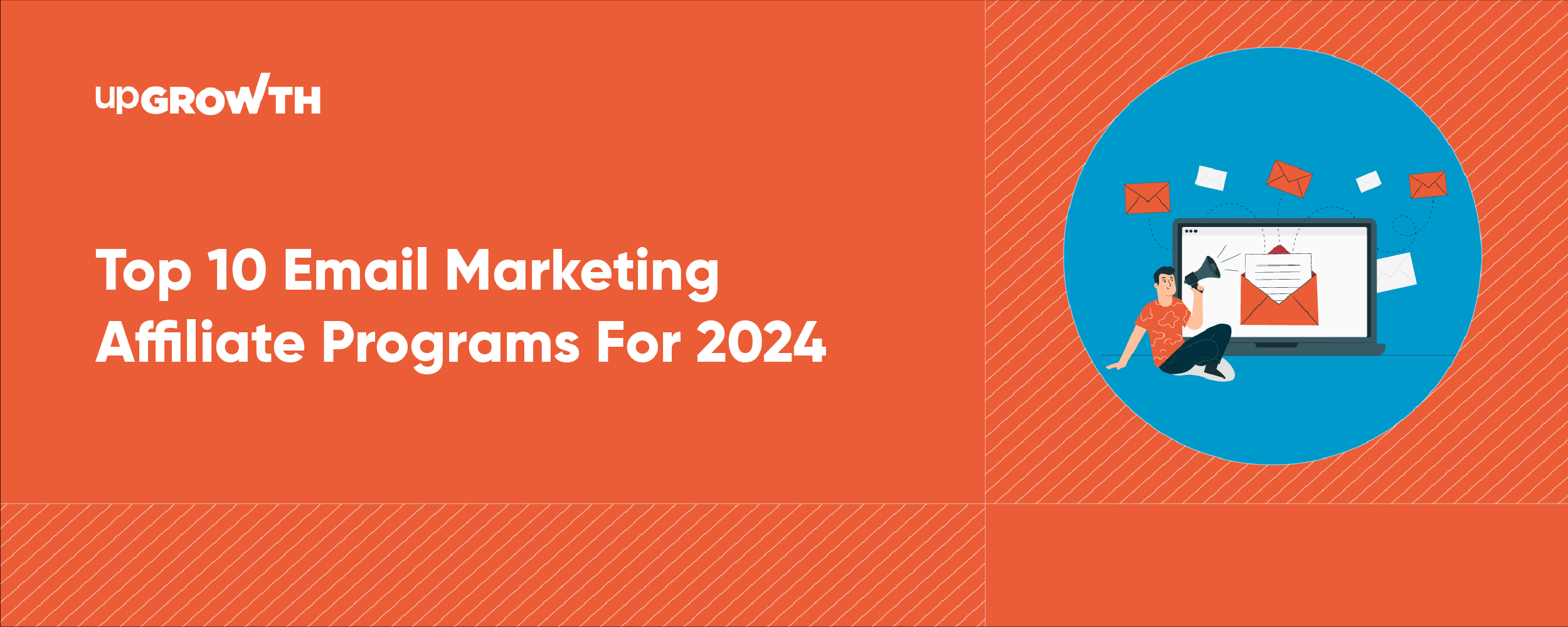Top 10 Email Marketing Affiliate Programs For 2025
Contributors:
Amol Ghemud
Published: February 1, 2021

Looking to stay ahead in 2025? Email marketing affiliate programs are emerging as a powerful way to boost revenue while building authentic connections with your audience. As personalization, AI, and automation continue to dominate digital marketing trends, these programs offer a seamless approach to promoting trusted products and services through engaging, data-driven content. By integrating affiliate links within targeted email campaigns, businesses can drive sales, enhance credibility, and tap into the growing demand for genuine recommendations—all while unlocking a steady stream of passive income.
This blog has affiliate email marketing tips that will help you achieve your target growth.
The Power of Affiliate Email Marketing
Affiliate marketing in emails is like teaming up with others to talk about products or services. It’s when someone you trust recommends a product or service in an email, and if you end up buying it, they get a little something in return. This helps companies get noticed by new people and sell more things, while the person sharing gets a bonus for recommending something they like. It’s a win-win situation for both! Following are a few pros of affiliate marketing through email:
- Higher credibility and conversion rates: Recommendations made by affiliates hold substantial weight as they come from trusted sources, resulting in increased credibility and higher chances of conversions.
- Cost-effective marketing strategy: Affiliate marketing in emails often operates on a performance-based model, where businesses pay affiliates only when a specific action, like a sale, occurs. This makes it a cost-effective marketing strategy with potentially high returns on investment.
- Leverages established relationships and trust: Affiliate marketing in email campaigns capitalizes on existing trust and relationships between affiliates and their audience, enhancing credibility and influencing purchasing decisions.
- Expands reach through partnerships: Collaborating with affiliates allows businesses to access new audiences that affiliates have cultivated, extending the reach of marketing efforts beyond the business’s direct sphere.
Top 10 Email Marketing Affiliate Programs for 2025
1. ActiveCampaign Affiliate Program
- Commission Rate: Up to 30% recurring
- Best Feature: Powerful email automation and CRM tools with a strong reputation for conversions. Ideal for businesses of all sizes.
2. ConvertKit Affiliate Program
- Commission Rate: 30% recurring
- Best Feature: Perfect for creators with easy-to-use tools for bloggers and small businesses to engage audiences.
3. GetResponse Affiliate Program
- Commission Rate: $100 per sale or 33% recurring
- Cookie Duration: 120 days
- Payout Method: PayPal or bank transfer
- Best Feature: Two-tier affiliate structure allows earning from both referrals and sub-affiliates. Advanced automation features.
4. Amazon Associates Program (Email Integration)
- Commission Rate: 1%–10% (depending on the category)
- Cookie Duration: 24 hours
- Payout Method: Bank transfer, Payoneer, or gift cards
- Best Feature: Massive product inventory makes it easy to tailor emails to any audience. Trusted global brand boosts conversions.
5. Mailchimp Partner Program
- Commission Rate: Up to $300 per referral
- Best Feature: Recognized as one of the top email marketing platforms, its tools cater to SMBs and agencies alike.
6. Moosend Affiliate Program
- Commission Rate: 30% recurring
- Payout Method: PayPal or wire transfer
- Best Feature: Affordable yet feature-packed, offering AI tools that appeal to startups and growing businesses.
7. Constant Contact Affiliate Program
- Commission Rate: $5 per lead, $105 per sale
- Cookie Duration: 120 days
- Best Feature: Known for excellent customer support and an intuitive platform for small and medium businesses.
8. Sendinblue Affiliate Program
- Commission Rate: €5 per free signup, €100 per sale
- Payout Method: Bank transfer or PayPal
- Best Feature: All-in-one platform integrating email, CRM, and SMS, ideal for scaling businesses.
9. HubSpot Affiliate Program
- Commission Rate: Up to $1,000 per sale
- Best Feature: Premium email marketing and CRM tools with high-ticket commissions for B2B affiliates.
10. Drip Affiliate Program
- Commission Rate: 30% recurring
- Best Feature: Tailored for e-commerce businesses with advanced segmentation and revenue-driving automation tools.
Affiliate marketing through email campaigns continues to be lucrative in 2025, especially with these top-notch programs offering competitive commissions, extended cookie durations, and advanced tools. Whether you’re targeting creators, SMBs, or e-commerce businesses, these platforms provide endless opportunities to earn while delivering value to your audience. Start leveraging these affiliate programs today and watch your marketing efforts become a steady stream of passive income!
How to Join and Succeed in Email Marketing Affiliate Programs
Consider the following points and affiliate email marketing tips to choose the best program for you and achieve success through it:
Research and Select Programs: Explore various email marketing affiliate programs, considering factors like commission rates, cookie duration, payout methods, and available resources. Choose programs that align with your niche and audience interests.
Register and Apply: Sign up for the chosen affiliate programs. Follow the application process, which often involves providing information about your marketing channels and audience reach. Some programs might require approval before you can start promoting.
Leverage Affiliate Resources: Once accepted, access the provided resources. These may include promotional materials such as banners, links, or creatives. Leverage these assets to create compelling and engaging content for your audience.
Promote Ethically: Create authentic, value-driven content that promotes the affiliate products subtly within your email marketing campaigns. Be transparent about your affiliate relationships to build trust with your audience.
Monitor and Optimize: Track your affiliate links’ performance using tracking tools provided by the programs. Analyze data to understand which strategies and campaigns are yielding better results. Optimize your approach based on insights gathered.
Criteria and Expectations for Affiliate Marketers in 2025
Affiliate marketing in 2025 demands adaptability, technological proficiency, and audience-centric strategies. Below are the key criteria and expectations to succeed in this dynamic landscape.
1. Strong Personal Branding and Authenticity
Affiliate marketers must build a personal brand that resonates with their audience. Transparency, credibility, and providing genuine value are critical to standing out in a crowded market. Trust will remain the foundation of successful affiliate relationships, requiring marketers to deliver high-quality, authentic content consistently.
2. Mastery of AI and Data-Driven Strategies
In 2025, leveraging AI tools for personalized content creation, performance tracking, and audience insights is no longer optional. Marketers must use advanced analytics and AI-driven automation to optimize campaigns, making them more targeted and efficient. Understanding audience behavior through data will be key to staying competitive.
3. Compliance with Evolving Privacy Laws
With stricter data privacy regulations like GDPR and other regional frameworks, affiliate marketers must implement ethical practices in tracking and data usage. Transparent disclosure of affiliate links and respecting user consent are essential for maintaining credibility and avoiding legal issues.
4. Multi-Channel Content Strategies
Diversification across platforms is a necessity. Affiliate marketers are expected to engage audiences through short-form videos, long-form blogs, podcasts, and even emerging technologies like AR/VR. Meeting audiences where they spend their time ensures relevance and maximizes impact.
5. Focus on Micro-Niches
Success increasingly lies in catering to hyper-specific niches rather than broad categories. By targeting specialized audience segments, marketers can create highly personalized campaigns that address unique needs, leading to higher conversion rates and stronger customer loyalty.
6. Sustainability and Ethical Marketing Practices
Promoting eco-friendly and socially responsible products is becoming a major expectation from both consumers and partner brands. Ethical marketing, combined with supporting causes aligned with the audience’s values, will boost engagement and build long-term trust.
7. Performance-Based Results
Brands and businesses expect clear, measurable results from affiliate marketers. Focusing on performance metrics like conversions, customer lifetime value, and ROI will determine the sustainability of affiliate partnerships. Demonstrating tangible results will be key to retaining and attracting lucrative collaborations.
By aligning with these evolving criteria, affiliate marketers in 2025 can stay ahead of the curve and ensure sustainable growth in an ever-changing digital landscape.
Promotion and Marketing Strategies
Content Optimization: Tailor content for different platforms and audiences. Focus on SEO, engaging visuals, and compelling storytelling.
Email Campaigns: Leverage email lists to promote products subtly. Offer value-driven content and recommendations.
Social Media Presence: Utilize various platforms for promotions. Create engaging posts, use influencer collaborations, and share affiliate links strategically.
Review and Comparison Content: Create informative reviews, comparisons, or tutorials that help users make informed decisions.
Paid Advertising: Use paid ads on social media or search engines to amplify reach and target specific audiences effectively.
Measuring Affiliate Marketing Success
Measuring the success of affiliate marketing entails an array of metrics and analyses. Key among these metrics is the conversion rate, which tracks the percentage of users who perform the desired action—such as making a purchase or signing up—based on your referrals. Understanding the Click-Through Rate (CTR) helps gauge the effectiveness of your affiliate links by assessing the ratio of clicks to impressions. Earnings per Click (EPC) quantifies how much revenue your clicks generate on average.
Metrics like Return on Investment (ROI) and Return on Advertising Spend (ROAS) are crucial in evaluating the profitability of your marketing efforts. Assessing Customer Lifetime Value (CLV) provides insights into the long-term value of customers acquired through your referrals. Tracking traffic sources is essential to optimize strategies and engagement, while employing different attribution models can accurately attribute conversions to various channels or touchpoints. Finally, monitoring engagement metrics like time spent on site, bounce rates, and interaction with affiliate content aids in understanding audience behavior and interest levels.
Conclusion
As we enter 2025, the affiliate marketing landscape is more competitive and dynamic than ever. Success lies in adapting to emerging technologies, building genuine relationships with audiences, and aligning with ethical and performance-driven practices. By focusing on personal branding, leveraging AI tools, embracing sustainability, and delivering measurable results, affiliate marketers can meet the expectations of brands and consumers and carve out a thriving and impactful career. The future of affiliate marketing belongs to those who can balance innovation with authenticity and consistently deliver value in a rapidly evolving digital ecosystem.
FAQs
1. What are the best email marketing affiliate programs for 2025?
The top email marketing affiliate programs for 2025 include ActiveCampaign, ConvertKit, GetResponse, Mailchimp, Moosend, Constant Contact, Sendinblue, HubSpot, Amazon Associates, and Drip. These programs offer competitive commissions, long cookie durations, and advanced tools tailored to diverse marketing needs.
2. How can I join email marketing affiliate programs and start earning in 2025?
To get started, visit the official websites of these affiliate programs and register through their sign-up portals. Most programs require you to provide details about your audience and marketing channels. Once approved, you’ll receive your unique affiliate links and resources to begin promoting.
3. Are there specific criteria for affiliate marketers to be eligible for these programs in 2025?
Eligibility criteria typically include having a platform like a blog, website, or social media presence to promote the affiliate products. Some programs may also require a minimum level of audience engagement or traffic. A commitment to ethical and transparent promotions is often a key prerequisite.
4. What kind of commissions and incentives can I expect from email marketing affiliate programs in 2025?
Affiliate programs in 2025 offer various commission structures, including recurring commissions (up to 30%), fixed payouts (up to $1,000 per sale), or tiered incentives for sub-affiliate referrals. Cookie durations range from 30 to 120 days, allowing ample time to earn commissions from referred traffic.
5. How do I promote these affiliate programs effectively in 2025?
To promote affiliate programs effectively, create high-quality, value-driven content tailored to your audience’s needs. Use email campaigns, social media, blogs, and video content to highlight the benefits of the programs. Transparency, personalized recommendations, and leveraging AI tools to optimize campaigns will increase engagement and conversions.
About the Author
Optimizer in Chief
Amol has helped catalyse business growth with his strategic & data-driven methodologies. With a decade of experience in the field of marketing, he has donned multiple hats, from channel optimization, data analytics and creative brand positioning to growth engineering and sales.
 Growth Strategy and Planning
Growth Strategy and Planning Inbound Growth
Inbound Growth Growth Hacking
Growth Hacking Search Engine Optimization
Search Engine Optimization Paid and Performance Marketing
Paid and Performance Marketing Social Media Marketing
Social Media Marketing AI-Driven Growth Strategy
AI-Driven Growth Strategy
 Growth Tools
Growth Tools Offers
Offers


















Leave a Reply